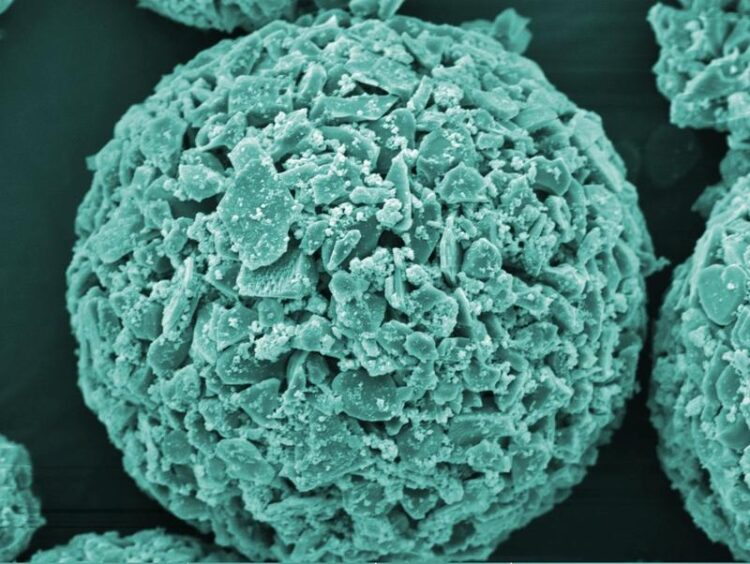Heavy charge against water germs

Ceramic granules made of aluminum oxide were coated with a nanometer-thin layer of copper oxide, as shown here at 5,000-fold magnification (electron microscopy, colored).
Sena Yüzbasi / Empa
Removing pathogens from drinking water is especially difficult when the germs are too tiny to be caught by conventional filters. Researchers at Empa and Eawag are developing new materials and processes to free water from pathogenic microorganisms such as viruses
Water is life, biology teaches us. Reality teaches us something different: Water contaminated with pathogens causes hundreds of thousands of deaths each year in places where water treatment is lacking or poorly functioning. To put an end to this, the availability of clean water for all mankind has been included in the United Nations (UN) Global Sustainability Agenda since 2015.
In accordance with this goal, Empa researchers, in collaboration with their colleagues at Eawag, are developing new materials and technologies to remove pathogens from drinking water, which until now could hardly be eliminated with conventional measures, or only with expensive and complex processes.
Tiny pathogens
The researchers are aiming at the smallest of germs: Tiny pathogens that – unlike the currently circulating coronavirus Sars-Cov-2 – are spreading via contaminated water and thus cause various water-borne diseases such as polio, diarrhea and hepatitis. Among these pathogens is the rotavirus, which is only about 70 nanometers in size.
“Conventional water filters are ineffective against rotaviruses,” explains Empa researcher Thomas Graule from Empa’s High Performance Ceramics lab in Dübendorf. However, it is precisely these tiny germs that are among the most common pathogens causing gastrointestinal infections. According to the World Health Organization (WHO), in 2016 around 130,000 children worldwide died from rotavirus infections. The researchers have now developed strategies for filtration technologies based on new materials that cleverly circumvent the problem of minuteness. This is because one property of the virus particles can be used for a new type of filter: the negative electrical charge of the virus particles.
Based on this idea, the researchers began to develop suitable materials that allow the adsorption of negatively charged virus surfaces. Until now, it has been difficult to create easily regenerated positively charged surfaces with high adsorption capacity, and systematic experimental studies have been scarce. For their investigations, the researchers therefore chose a model virus that is even smaller than the rotavirus: the bacteriophage MS2, which is only 27 nanometers in size – a virus that attacks bacteria but is harmless to humans. Using this model virus, the scientists were able to show that viruses in water adsorb to the filter surface to varying degrees depending on the water’s pH. “This must be taken into account when developing new water treatment and filter technologies,” says Graule.
Porous nanocoating
In order to develop filter technologies that can capture viruses at the nanometer scale, Graule is focusing on composite materials that are functionalized in such a way that they specifically bind viruses. “In water, the surface of the virus particles is negatively charged. We were able to show how the virus particles attach themselves to positively charged surfaces,” he explains. For example, the researcher is working in an international team on ceramic granules made of aluminum oxide, whose fine granules are coated with nanometer-thin layers of copper oxide. “Together with the ceramic, the highly porous copper layer forms a composite material with a positively charged and immensely large specific surface,” says Graule. The researchers were also able to coat tiny multi-layer carbon nanotubes with copper oxide, thus enabling virus elimination.
In order to develop a cost-effective and sustainable filter technology, the researchers specifically utilize materials that can be recovered after use in the sense of a closed material cycle. It is also important that no filter components are washed out into the purified water. To this end, analytical methods for nano-safety still need to be developed so that the most suitable composite material can be determined. At the end of the project, a filter technology is expected to be available that is also suitable for water treatment in developing countries with their particularly high numbers of rotavirus and other water-borne diseases.
Pathogens in drinking water
Worldwide, around 3.4 million people, mostly children in structurally underdeveloped countries, die every year from water-borne diseases. Among the pathogens are single-cell parasites, such as amoebae and lamblia with a size of up to 40 micrometers. Bacteria such as salmonella, which cause typhoid fever, E. coli germs and cholera pathogens are significantly smaller (0.5 to 6 micrometers), but equally potent pathogens. With a size of 25 to 80 nanometers – about 100 to 1000 times smaller – viruses are the most difficult pathogens to filter out of water. In developing countries the contamination of drinking water with rotaviruses is particularly widespread, followed by other viruses such as the pathogens that cause hepatitis and polio.
Wissenschaftliche Ansprechpartner:
Prof. Dr. Thomas Graule
Empa, High Perform. Ceramics
Phone +41 58 765 41 23
Thomas.Graule@empa.ch
Dr. Tim Julian
Eawag, Environ. Biology
Phone +41 58 765 56 32
Tim.Julian@eawag.ch
Weitere Informationen:
Media Contact
All latest news from the category: Health and Medicine
This subject area encompasses research and studies in the field of human medicine.
Among the wide-ranging list of topics covered here are anesthesiology, anatomy, surgery, human genetics, hygiene and environmental medicine, internal medicine, neurology, pharmacology, physiology, urology and dental medicine.
Newest articles

Bringing bio-inspired robots to life
Nebraska researcher Eric Markvicka gets NSF CAREER Award to pursue manufacture of novel materials for soft robotics and stretchable electronics. Engineers are increasingly eager to develop robots that mimic the…

Bella moths use poison to attract mates
Scientists are closer to finding out how. Pyrrolizidine alkaloids are as bitter and toxic as they are hard to pronounce. They’re produced by several different types of plants and are…

AI tool creates ‘synthetic’ images of cells
…for enhanced microscopy analysis. Observing individual cells through microscopes can reveal a range of important cell biological phenomena that frequently play a role in human diseases, but the process of…





















